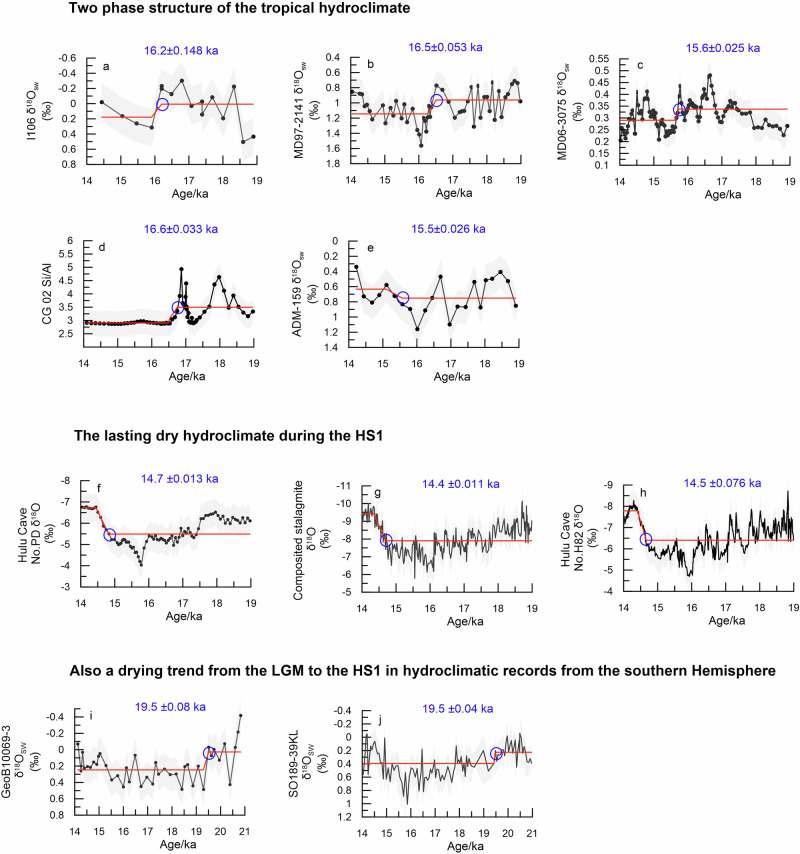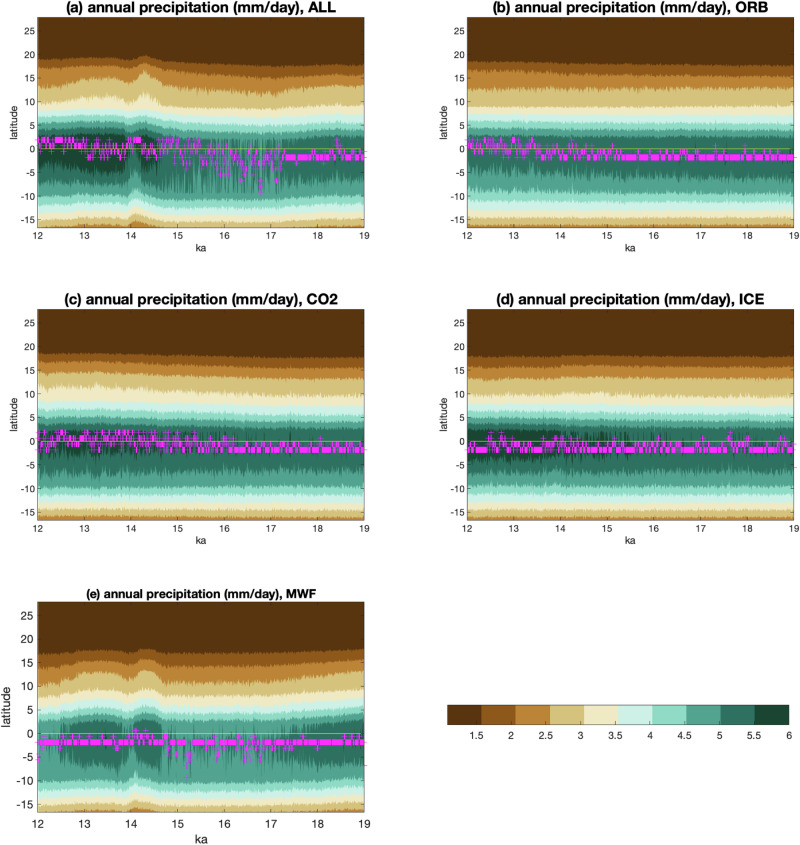replying to F. LU et al. Nature Communications 10.1038/s41467-024-53999-4 (2024)
We appreciate the comments made by Lu et al. in response to our paper “A Contracting Intertropical Convergence Zone during the Early Heinrich Stadial 1”, which was published in Nature Communications in August 20231. In their commentary, Lu et al. highlighted that the linearly interpolated age models in our study are not robust enough to define the humid event during the early Heinrich Stadial 1 (HS1). They re-evaluated the age models using the Bayesian age-depth model and claimed that the majority of proxy records, the same as Hulu Cave δ18O record, exhibit a dry trend during the early HS1. In this reply, we also re-establish all age models using a Bayesian approach and calculate the changing points during the HS1 for each core, which shows that there was indeed a two-phase structure of hydroclimate during the HS1, with a relatively humid condition in the early HS1 and a drought condition in the late HS1 in cores at low northern latitudes, although several hundred years differ between the Bayesian age model and linear interpolation method.
First, Lu et al. argued that “there are two main sources of uncertainty in paleoclimate records, i.e., proxy uncertainties and age uncertainties. The study of Yang et al. used a single, linearly interpolated age model without considering age uncertainties”. We would like to emphasize that we have utilized the Paleo-Seawater Uncertainty Solver (PSU Solver) to evaluate the proxy uncertainty with two signa analytical uncertainty of Mg/Ca and δ18O and ±5% age uncertainty2. We also recalculated the Bayesian age-depth models of each record using the R package “rbacon”3. The recalculated results show that the humidity events still occur in the early stage of HS1, although there are several hundred-year differences between the Bayesian age models and the linear interpolation age models (Please see Supplementary Dataset 1).
Second, Lu et al. has a misunderstanding about the basis (Hulu Cave δ18O record from Wu et al.4) for questioning and discussion. Numerous paleo-records and stalagmite δ18O records from East Asia show that there were dry conditions and a weak East Asian summer monsoon during the entire HS1. Lu et al. cited the No. H82 stalagmite δ18O record of Hulu Cave ( ~ 16.5–22 ka) from Wu et al.4 to represent the weak East Asian monsoon and a drying condition during the Heinrich Stadial 1, and he used this record to make a comparison with the humidity records of the early HS1 ( ~ 16.5–19 ka) at low northern latitudes. However, Wu et al.4 have clearly suggested that an exceptionally strengthened East Asian summer monsoon event between 19.9 and 17.1 ka BP was recorded in a Hulu stalagmite (No.H82), which may be a regional response to the Super-ENSO4. That is likely why Lu et al.’s comparison shows that 4/5 of humidity records of the early HS1 at low northern latitudes are consistent with Hulu Cave δ18O record from Wu et al.4 Simultaneously, other stalagmite δ18O records from Hulu Cave (No. PD)5, Sanbao Cave6,7 showed that the East Asian summer monsoon was weak during the entir HS1.
Third, in Yang et al. (2023)1, we focused on a two-phase structure of the tropical hydroclimate during the HS1 at the low northern latitudes, rather than the climate changes between the Large Glacial Maximum (LGM) and the HS1 in Lu et al.’s Fig. 1. In this response, we calculated the change point for each record within HS1 (14-19 ka) by a change-point analysis approach in RAMPFIT software8, which is suitable for the paleoclimatic data. Our results show that there was a change point at approximately 16.0 ka in all humid records of early HS1 (Fig. 1a–e), while the change point in stalagmite δ18O records was about 14.6 ka due to the weak East Asian Monsoon during the entire HS1 (Fig. 1f–h). Of course, the length of the time series used in the analyses possible has an important influence for the difference of the changing point in this study and Lu et al.’s commentary. In addition, the hydroclimate records from the Southern Hemisphere also exhibit a drying trend from the LGM to the HS1, as well as the records from the Northern Hemisphere in Lu et al.’s commentary (Fig. 1i, j). This also not support the opinion of the southward migration of the ITCZ.
Fig. 1. Comparison of turning points and trends in hydroclimatic changes during the last deglaciation in the Indo-Asian-Australian (IAA) monsoon region.
a–e tropical hydroclimatic records of cores I106, MD97-2141, MD06-3075, CG02, ADM-159 from the low northern latitudes show a two-phase structure within Heinrich Stadial 1 (HS1) and a turning point at approximately 16.0 ka, (f–h) subtropical hydroclimatic records by stalagmite δ18O suggest a lasting dry condition during the entire HS1, with a turning point at approximately 14.6 ka, (i–j) hydroclimatic records by seawater δ18O (δ18Osw) in the southern hemisphere also show a drying trend from the Large Glacial Maximum (LGM) to the HS1 (14–21 ka), with a turning point of approximately 19.5 ka, as the same as the commentary of Lu et al.’s on the hydroclimatic records in the northern hemisphere. The red line indicates the trend of hydroclimatic change, and the blue circle indicates the turning point of the hydroclimatic.
Fourth, Lu et al. argued that “However, seawater δ18O is not only controlled by rainfall and evaporation, but also by the advection of water masses (laterally or vertically) and ocean current changes. The marine records used to infer dry conditions in the Southern Hemisphere during the early HS1 by Yang et al. lie in routes of South Java Current (GeoB10042-1), the Indonesian Throughflow (ITF) (SO217-18519, SO217-18515, MD01-2378, MD98-2165 and GeoB10069-3 and the Mozambique Current (GIK16160-3).” We would like to emphasize that the authors of these reference papers have conducted a detailed discussion and analysis about the potential influencing factors, and insisted that the seawater δ18O records of these cores can well indicate monsoon and precipitation changes, not the currents and upwelling. At the same time, we noted that these data cited by Lu et al.’ s commentary are not consistent with the raw data from these original papers.
Last, Lu et al. argued that the Intertropical Convergence Zone (ITCZ) migrated southward rather than contracting during the early HS1 by the TraCE-21ka transient simulation (in his Fig. 2). The TraCE simulation may have flaws in representing the evolution of the ITCZ during the deglaciation. Using the precipitation differences between the two periods simulated in TraCE, Lu et al. argued that the ITCZ migrated southward rather than contracted during the early HS1. However, we have previously performed similar analyses using TraCE data (e.g. in our first response to the reviewer’s comments, Fig. R2), and found a contradiction between TraCE simulation and proxy data reconstructions. In fact, the spatial resolution (about 3.75 deg, or over 400 km) of TraCE is too coarse to identify robust spatial shift in the ITCZ (if defined by the maximum precipitation along a latitudinal band), particularly during the HS1, when the simulated precipitation reduced intensively in this region and became highly variable (Fig. 2). The difficulties in using TraCE simulation to represent deglacial regional-scale precipitation changes and compare them directly to proxies were reported in earlier studies9.
Fig. 2. Zonal mean annual precipitation between 20°E-120°E.
Hovmoller diagram of annual mean precipitation (shading color) in (a) TRACE and (b–e) TRACE single forcing simulations. The location of the maximum precipitation, an indicator of Intertropical Convergence Zone (ITCZ), is marked by purple “+“. The horizontal yellow line is for the equator. b–e for TRACE orbital forcing simulation, TRACE greenhouse gases forcing simulation, TRACE ice-sheet forcing simulation, and TRACE meltwater flux (MWF) forcing simulation.
In summary, we do not think Lu et al.’s commentary is sufficient to refute the hypothesis of ITCZ contraction. We have conducted a very careful and detailed analysis of the paleoclimatic records in the Indo-Asian-Australian (IAA) monsoon region. The variations in the tropical precipitation pattern during HS1 in the IAA monsoon region were complicated and could not be simply explained by the north-south shift of the ITCZ.
Supplementary information
Description of Additional Supplementary Files
Acknowledgements
We thank the National Natural Science Foundation of China for grants supporting Y. Y. (Grant No. 42376074), L.Z. (Grant No. 42176080) and R.X. (Grant No. 42176082), and the development fund of South China Sea Institute of Oceanology of the Chinese Academy of Sciences (Grant No. SCSIO202201 to Y.D. and L.Z.). Data and samples were collected onboard of SCSIO R/V “SHIYAN 6” implementing the open research cruise NORC2023-10 + NORC2023-303 supported by NSFC Shiptime Sharing Project (project number: 42249910).
Author contributions
Y.Y., Z.L., R.X. and L.Z. contributed to writing reply. L.Y. and F.Z. contributed to the age model analysis and the change point analysis. S.W. and Y.D. contributed to revising the manuscript.
Peer review
Peer review information
Nature Communications thanks the anonymous reviewer(s) for their contribution to the peer review of this work.
Competing interests
The authors declare no competing interests.
Footnotes
Publisher’s note Springer Nature remains neutral with regard to jurisdictional claims in published maps and institutional affiliations.
Contributor Information
Lanlan Zhang, Email: llzhang@scsio.ac.cn.
Rong Xiang, Email: rxiang@scsio.ac.cn.
Supplementary information
The online version contains supplementary material available at 10.1038/s41467-024-54001-x.
References
- 1.Yang Y. P. et al. A contracting Intertropical Convergence Zone during the Early Heinrich Stadial 1. Nat. Commun.14, 4695 (2023). [DOI] [PMC free article] [PubMed] [Google Scholar]
- 2.Thirumalai, K., Quinn, T. M. & Marino, G. Constraining past seawater δ18O and temperature records developed from foraminiferal geochemistry. Paleoceanography31, 1409–1422 (2016). [Google Scholar]
- 3.Blaauw, M., Christen, J. A., Bennett, K. D. & Reimer, P. J. Double the dates and go for Bayes — Impacts of model choice, dating density and quality on chronologies. Quat. Sci. Rev.188, 58–66 (2018). [Google Scholar]
- 4.Wu, J. Y., Wang, Y. J., Cheng, H. & Edwards, L. R. An exceptionally strengthened East Asian Summer monsoon event between 19.9 and 17.1 ka BP recorded in a Hulu stalagmite. Sci. China Ser. D: Earth Sci.52, 360–368 (2009). [Google Scholar]
- 5.Wang, Y. J. et al. A High-Resolution Absolute-Dated Late Pleistocene Monsoon Record from Hulu Cave, China. Science294, 2345–2348 (2001). [DOI] [PubMed] [Google Scholar]
- 6.Wang, Y. et al. Millennial- and orbital-scale changes in the East Asian monsoon over the past 224,000 years. Nature451, 1090–1093 (2008). [DOI] [PubMed] [Google Scholar]
- 7.Cheng, H. et al. The Asian monsoon over the past 640,000 years and ice age terminations. Nature534, 640–646 (2016). [DOI] [PubMed] [Google Scholar]
- 8.Mudelsee, M. Ramp function regression: A tool for quantifying climate transitions. Comput. Geosci.26, 293–307 (2000). [Google Scholar]
- 9.Gordon, A. L., Susanto, R. D. & Vranes, K. Cool Indonesian throughflow as a consequence of restricted surface layer flow. Nature425, 824–828 (2003). [DOI] [PubMed] [Google Scholar]
Associated Data
This section collects any data citations, data availability statements, or supplementary materials included in this article.
Supplementary Materials
Description of Additional Supplementary Files




